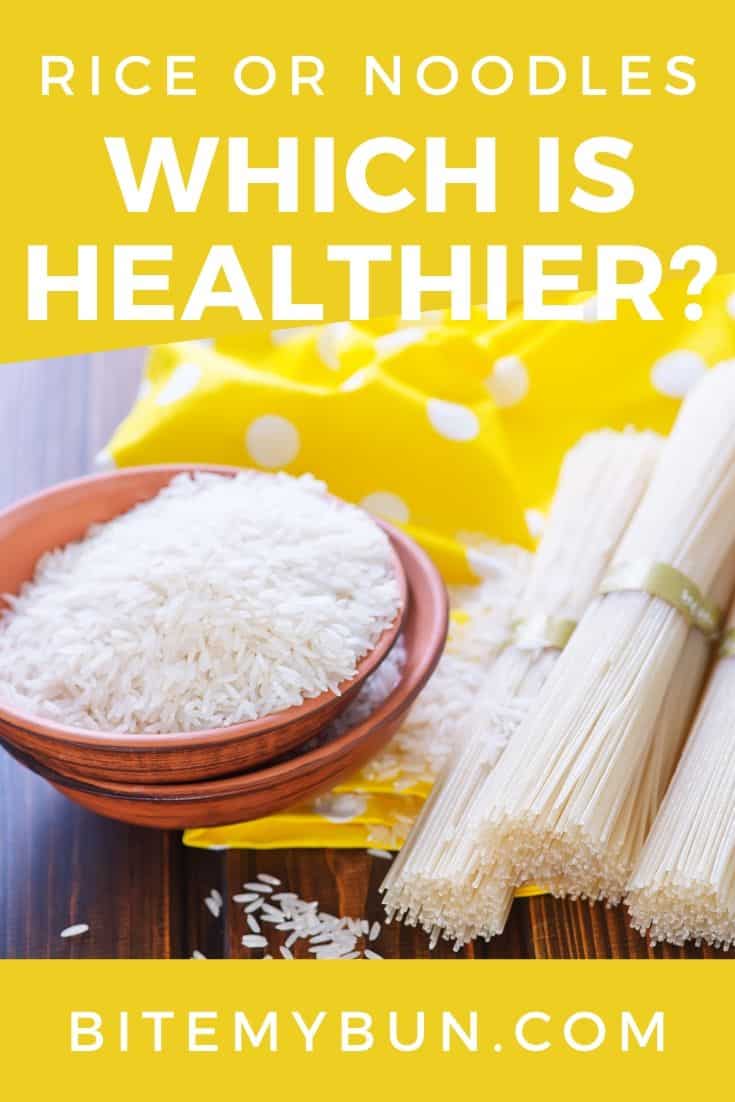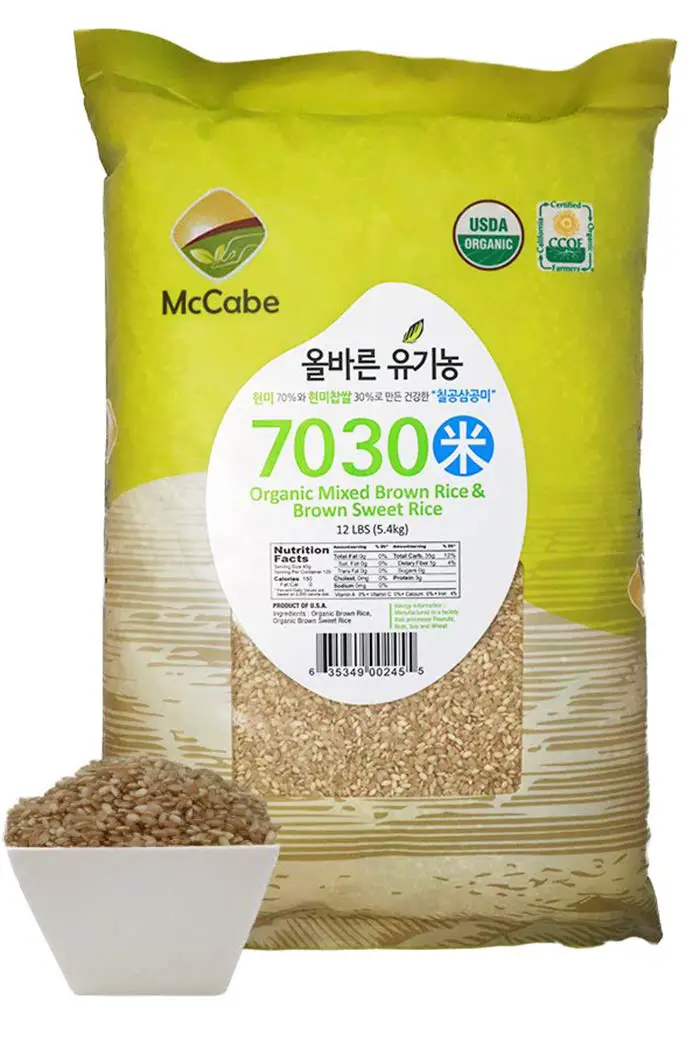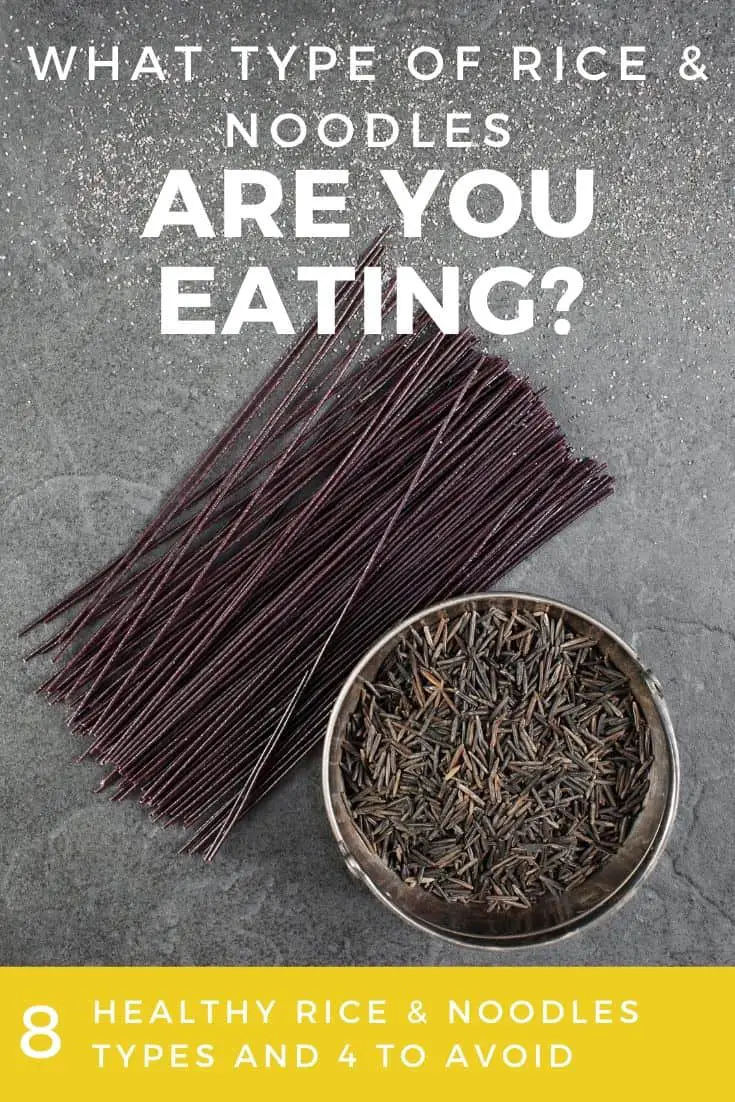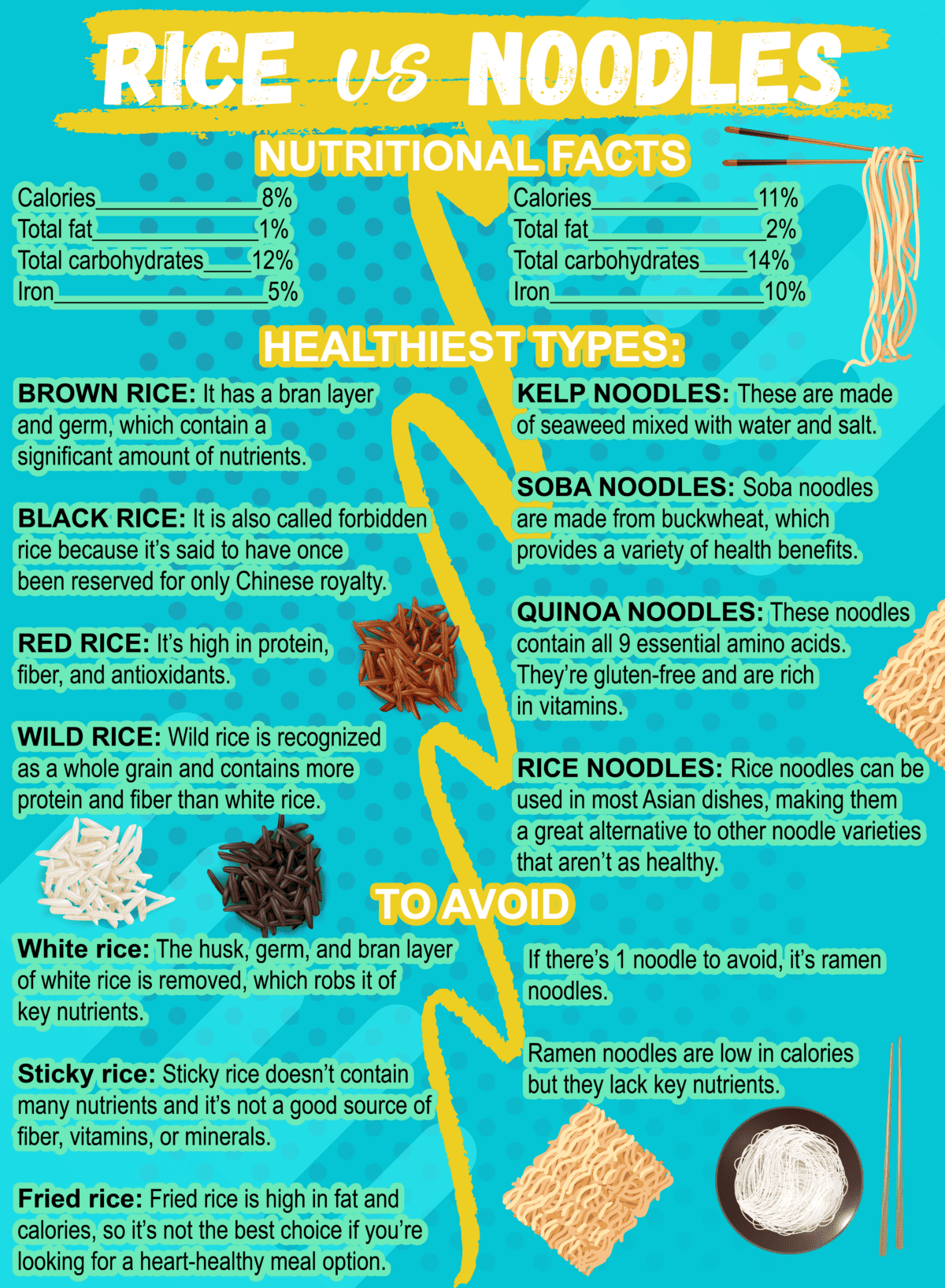Rice or noodles: Which is healthier? Carbs, calories & more
If you’re looking for a starchy side for your meals, both rice and noodles are tasty options.
But if you’re trying to pick one based on health, things can get a bit confusing. After all, they’re both carbohydrates have a similar consistency.
However, there are some differences that may make one better than the other.
Although it’s hard to pick a clear winner, this post will guide you through your options and what to look out for in health benefits.

Now, before you say: it depends on the type of rice or noodles you’re eating!
Sure, you’re always better off choosing the healthiest options:
| Healthy options | Images |
|---|---|
| Healthiest noodles: Better Than Noodles | 
|
| Healthiest rice: McCabe organic brown rice | 
|
Here’s how basic white rice and wheat noodles compare.

Check out our new cookbook
Bitemybun's family recipes with complete meal planner and recipe guide.
Try it out for free with Kindle Unlimited:
Read for freeIn this post we'll cover:
Rice nutritional facts
For a serving size of 1 cup (164 g):
| Contents | Per serving | % Daily value |
|---|---|---|
| Calories | 166g | 8% |
| Calories from fat | 5g | |
| Total fat | 1g | 1% |
| Saturated fat | 0g | |
| Trans fat | 0g | |
| Cholesterol | 0mg | 0% |
| Sodium | 5mg | 0% |
| Total carbohydrates | 35g | 12% |
| Dietary fiber | 3g | 12% |
| Sugars | 1g | |
| Protein | 7g | |
| Vitamin A | 0% | |
| Vitamin C | 0% | |
| Calcium | 0% | |
| Iron | 5% |
The percentage of daily value is based on a 2,000 calorie diet.
Noodles nutritional facts
For a serving size of 1 cup (140 g):
| Contents | Per serving | % Daily value |
|---|---|---|
| Calories | 220g | 11% |
| Calories from fat | 11g | |
| Total fat | 1g | 2% |
| Saturated fat | 0g | 1% |
| Trans fat | 0g | |
| Cholesterol | 0mg | 0% |
| Sodium | 183mg | 8% |
| Total carbohydrates | 43g | 14% |
| Dietary fiber | 3g | 10% |
| Sugars | 1g | |
| Protein | 8g | |
| Vitamin A | 0% | |
| Vitamin C | 0% | |
| Calcium | 1% | |
| Iron | 10% |
The percentage of daily value is based on a 2,000 calorie diet.
How do rice and noodles compare?
Let’s look at that same table for 100gs of both rice and noodles:
| Contents | Rice | Noodles |
|---|---|---|
| Calories | 101g | 157g |
| Calories from fat | 3g | 8g |
| Total fat | 0.6g | 0.7g |
| Saturated fat | 0g | 0g |
| Trans fat | 0g | 0g |
| Cholesterol | 0mg | 0mg |
| Sodium | 3mg | 130mg |
| Total carbohydrates | 21g | 31g |
| Dietary fiber | 1.8g | 2g |
| Sugars | 0.6g | 0.7g |
| Protein | 4.3g | 5.7g |
| Vitamin A | 0% | 0% |
| Vitamin C | 0% | 0% |
| Calcium | 0% | 0.7% |
| Iron | 3% | 7% |
Let’s take a closer look at both of these types of carbs to figure out which one is best.
What’s a carbohydrate?
Before we get into which starch is best for you, let’s take a look at what carbohydrates are and how they work in our bodies.
Carbs have gotten a bad rap over the years. However, they’re nutrients that are necessary for our bodies!
When we eat carbohydrates, they’re converted to glucose. Glucose serves as fuel for our cells and therefore provides our body with energy.
However, not all carbs are created equal.
There are 2 types of carbohydrates:
- Simple carbohydrates: Simple carbohydrates are also known as refined or processed grains. The grains are processed to increase shelf life but during the process, the grain loses some of its nutrients. Foods that are simple carbohydrates include bread, pastries, cakes, and most regular rice and pasta products.
- Complex carbohydrates: This type of carbohydrate doesn’t go through processing and therefore, has a richer vitamin and mineral content. Common types of complex carbohydrates include bread, quinoa, black rice, brown rice, fruits, and vegetables.
Now let’s take a look at a closer look at which is healthier.
Calories
Looking at these 2 nutritional panels, it’s clear that if you’re making a judgment of which food is healthier based on calorie count, rice will come out ahead.
The same number of calories can be found in 100 grams of rice as can be found in 50 grams of noodles. The calorie count here for this amount of food is around 175.
The percentage of fat is also higher in noodles, with rice having 1% fat as compared to noodles’ 2%.
However, it should be noted that certain types of rice (like fried rice) can be higher in fat and calories.
Vitamins
Neither noodles nor rice is exceptionally rich in vitamins and minerals. However, both do contain iron, which is a necessary nutrient for the body.
Noodles contain 10% iron in comparison to rice’s 5%.
Noodles also contain 1% calcium, which is beneficial to bones. Rice doesn’t have any calcium.
Sodium
Sodium is a mineral that helps control your body’s fluid levels. It also aids in nerve impulses and muscle control.
However, excessive sodium intake can cause high blood pressure.
Sodium levels are considerably higher in noodles. They contain 8% sodium while rice doesn’t have any.
Carbohydrates
Noodles have a higher carbohydrate percentage than rice. It comes in at 14% in comparison with rice’s 12%. Considering that you need carbs for bulking, noodles will be better for weightlifting and bodybuilding.
Fiber
Fiber is beneficial to gut health. It can reduce blood sugar, lower cholesterol levels, and decrease appetite. Rice has a fiber level of 12%, beating noodles by 2%.
Protein
Protein is a component that plays a role in every cell of your body.
It aids in the building and repairing of tissue and is also used to make enzymes, hormones, and other body chemicals. It’s a building block of bones, muscles, cartilage, skin, and blood.
Both noodles and rice have similar amounts of protein with noodles having 8g, compared to rice’s 7g.
Simple or complex carbs
Most types of noodles and rice are made from refined grains.
Consuming an excessive amount of refined grains can lead to metabolic syndrome, which is characterized by symptoms like high blood pressure, high cholesterol levels, and excess abdominal fat. They can also trigger inflammation in the body to increase the risk of disease.
Glycemic index
Glycemic index measures how food impacts your blood sugar. High glycemic levels will cause it to rise.
If food has a glycemic level above 70, it’s considered high. Levels of 56-69 are considered moderate while levels below 55 are low.
Rice has a glycemic level of around 73 while the glycemic level of noodles is moderate.
Also read: these 22 sauces will make any rice into a delicious meal
What types of rice/noodles are you eating?

So it seems as if both rice and noodles have their share of pros and cons and you may choose one over the other based on your health needs.
But not so fast….
Before making a decision, you should consider that there are many different types of noodles and rice available, and some are healthier than others.
If you’re looking for the healthiest carbohydrates, here are some that are recommended.
Healthiest types of noodles
If you’re looking for healthy noodles, here are some you’ll want to check out:
- Kelp noodles: These are made of seaweed mixed with water and salt. They contain only 20 calories a gram and are a great source of iodine, vitamin K, B vitamins, zinc, iron, and antioxidants. I’ve written a complete guide on kelp noodles here, with a delicious recipe to try.
- Soba noodles: Soba noodles are made from buckwheat, which provides a variety of health benefits. They’re rich in antioxidants, fiber, and magnesium, which improves blood flow. They’re also gluten-free, and you can read about soba noodles in my yakisoba post.
- Quinoa noodles: These noodles contain all 9 essential amino acids. They’re gluten-free and are rich in vitamins and minerals like vitamin E, B vitamins, and iron.
- Rice noodles: Rice noodles can be used in most Asian dishes, making them a great alternative to other noodle varieties that aren’t as healthy. They’re gluten-free and contain only 100 calories per serving.
Healthiest types of rice
When it comes to healthy rice, here are some types that are recommended:
- Brown rice: Unlike white rice, brown rice has a bran layer and germ, which contain a significant amount of nutrients. It also contains flavonoid antioxidants that protect the body from disease, and it’s high in protein and fiber.
- Black rice: Black rice is also called forbidden rice because it’s said to have once been reserved for only Chinese royalty. It has the highest antioxidant activity of any type of rice and it also has anti-inflammatory properties.
- Red rice: Red rice is rich in nutrients and beneficial plant compounds. It’s high in protein, fiber, and antioxidants. It’s also been shown to decrease inflammation.
- Wild rice: Wild rice is recognized as a whole grain and contains more protein and fiber than white rice. It’s also been shown to reduce the risk of heart disease. It’s rich in antioxidants and vitamins, and minerals like B vitamins, magnesium, and manganese.
Types of noodles to avoid
If there’s 1 noodle to avoid, it’s ramen noodles. Ramen noodles are low in calories but they lack key nutrients.
Ramen noodles are made with wheat flour that’s been fortified with synthetic forms of nutrients to make them more nutritious.
But they’re lacking in other vitamins and minerals like protein, fiber, vitamins A, C and B12, calcium, magnesium, and potassium. They’re also low in antioxidants and phytochemicals.
Types of rice to avoid
Here are some types of rice you will want to steer clear of:
- White rice: The husk, germ, and bran layer of white rice is removed, which robs it of key nutrients. Yet it’s still rich in carbohydrates. Because it lacks nutrients, the body processes it into sugar, leaving you hungry after eating it. It also has a high glycemic level that can cause blood sugar to spike.
- Sticky rice: Sticky rice doesn’t contain many nutrients and it’s not a good source of fiber, vitamins, or minerals. It contains a high fructose corn syrup that contributes to the calorie content and raises blood sugar.
- Fried rice: Fried rice is high in fat and calories, so it’s not the best choice if you’re looking for a heart-healthy meal option.

Which will you choose, rice or noodles?
So it seems there’s no clear answer to which is healthier: noodles or rice.
Both have advantages and disadvantages, and one may be better for your health needs than the other. The kind of noodles and rice you’re eating will also be a deciding factor.
The best thing to do is to make healthy choices at each meal based on your tastes and what you think is right for you.
Here’s to making your meals delicious and nutritious every time!
Check out our new cookbook
Bitemybun's family recipes with complete meal planner and recipe guide.
Try it out for free with Kindle Unlimited:
Read for freeJoost Nusselder, the founder of Bite My Bun is a content marketer, dad and loves trying out new food with Japanese food at the heart of his passion, and together with his team he's been creating in-depth blog articles since 2016 to help loyal readers with recipes and cooking tips.
